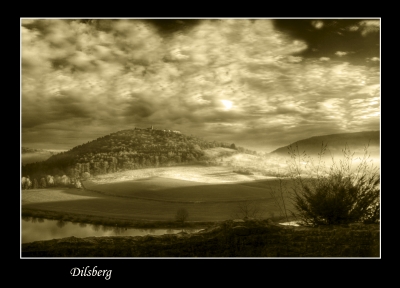
Every medieval town had its mysteries.
Dilsberg, a walled town atop a hill that towers above Germany’s Neckar River, was no exception. Its mystery was its defense. Dilsberg had never been conquered in a siege, and the besiegers could never figure out how the Dilsbergers remained fat and well-armed even after their access to the outside world was cut off.
Who would have thought that a traveling American would hit upon a secret that had eluded generals and armies?
Mark Twain in Germany
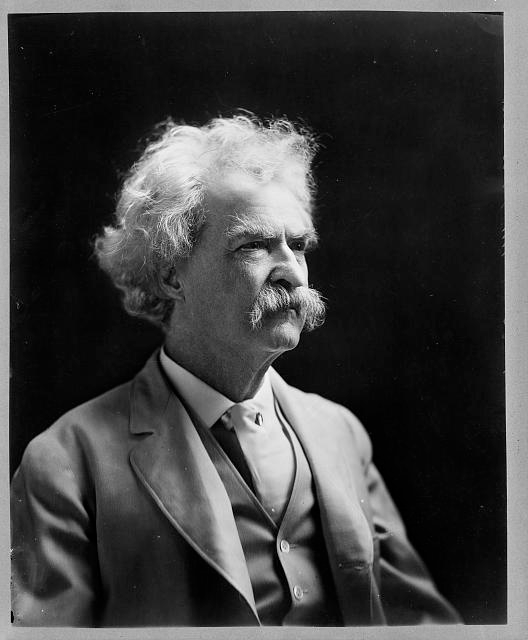
When Mark Twain traveled to Germany in 1878, he never planned to solve a military mystery. He was in the middle of writing Huckleberry Finn and had ideas for a new book on European travel, A Tramp Abroad. In the summer of 1878 he took a trip down the Neckar and Dilsberg caught his eye.
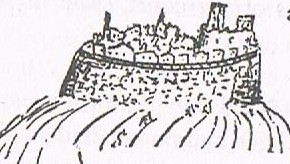
“For Dilsberg is a quaint place. It is most quaintly and picturesquely situated, too. Imagine the beautiful river before you; then a few rods of brilliant green sward on its opposite shore; then a sudden hill, – no preparatory gently-rising slopes, but a sort of instantaneous hill, – a hill two hundred and fifty or three hundred feet high, as round as a bowl…, and with just exactly room on the top of its head for its steepled and turreted and roof-clustered cap of architecture, which same is tightly jammed and compacted within the perfectly round hoop of the ancient village wall…. [F]rom a distance Dilsberg has rather more the look of a king’s crown than a cap.”
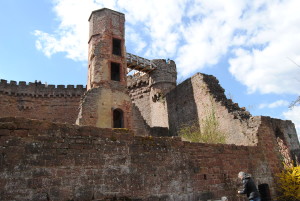
Twain hiked up the hill to visit the town. Once inside the city wall, he explored the castle ruins. “It proved to be an extensive pile of crumbling walls, arches, and towers, massive, properly grouped for picturesque effect…” Children accompanied him and acted as his tour guides. They climbed the castle tower and walked on its lofty battlements.
Dilsberg and the legend of the secret passage
It was the children who let him in on the secret. “But the principal show, the chief pride of the children, was the ancient and empty well in the grass-grown court of the castle. Its massive stone curb stands up three or four feet above the ground, and is whole and uninjured…. There were some who believed it had never been a well at all, and was never deeper than it is now, – eighty feet; that at that depth a subterranean passage branched from it and descended gradually to a remote place in the valley, where it opened into somebody’s cellar or other hidden recess, and that the secret of this locality is now lost.”
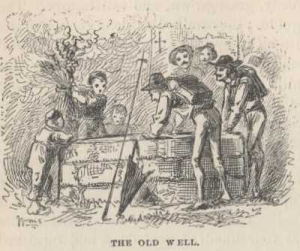
This, Twain said, was the secret to Dilsberg’s defense. Dilsbergers were bringing in supplies through the secret passage. The children tried to prove the existence of the passage to him by dropped burning straw down the well. It struck bottom and burnt out without any smoke coming up.
“You see!” said the children. “Nothing makes so much smoke as burning straw – now where did the smoke go to, if there is no subterranean outlet?”
But was the story true or not? Sometimes with Twain’s travel tales it’s hard to tell.
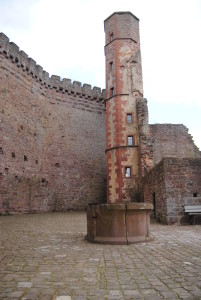
A Twain fan solves the mystery
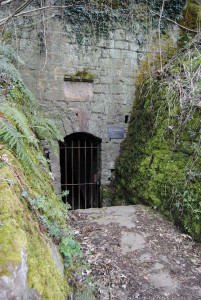
In 1900, one Twain fan decided to find out. Frank von Briesen, a German American, was fascinated by the well story. He traveled to Dilsberg, let himself down the well on a rope, and found a passageway blocked by rubble. In 1926 he paid to have the outlet cleared. It terminated in the wooded hillside. The tunnel is now open to the public and the city of Dilsberg offers tours in the summer. Historians believe it was probably built to provide air circulation. But who knows? Maybe the Dilsbergers also used it during sieges to get supplies.
And maybe Mark Twain really did solve one of Germany’s mysteries for the outside world. If it hadn’t been for Twain and one of his fans, knowledge of the secret passage might have been lost.
Literature on point
All quotes from Mark Twain, A Tramp Abroad (public domain)
Werner Pieper, ed., Mark Twain’s Guide to Heidelberg (Löhrbach: Werner Pieper’s MedienXperimente)

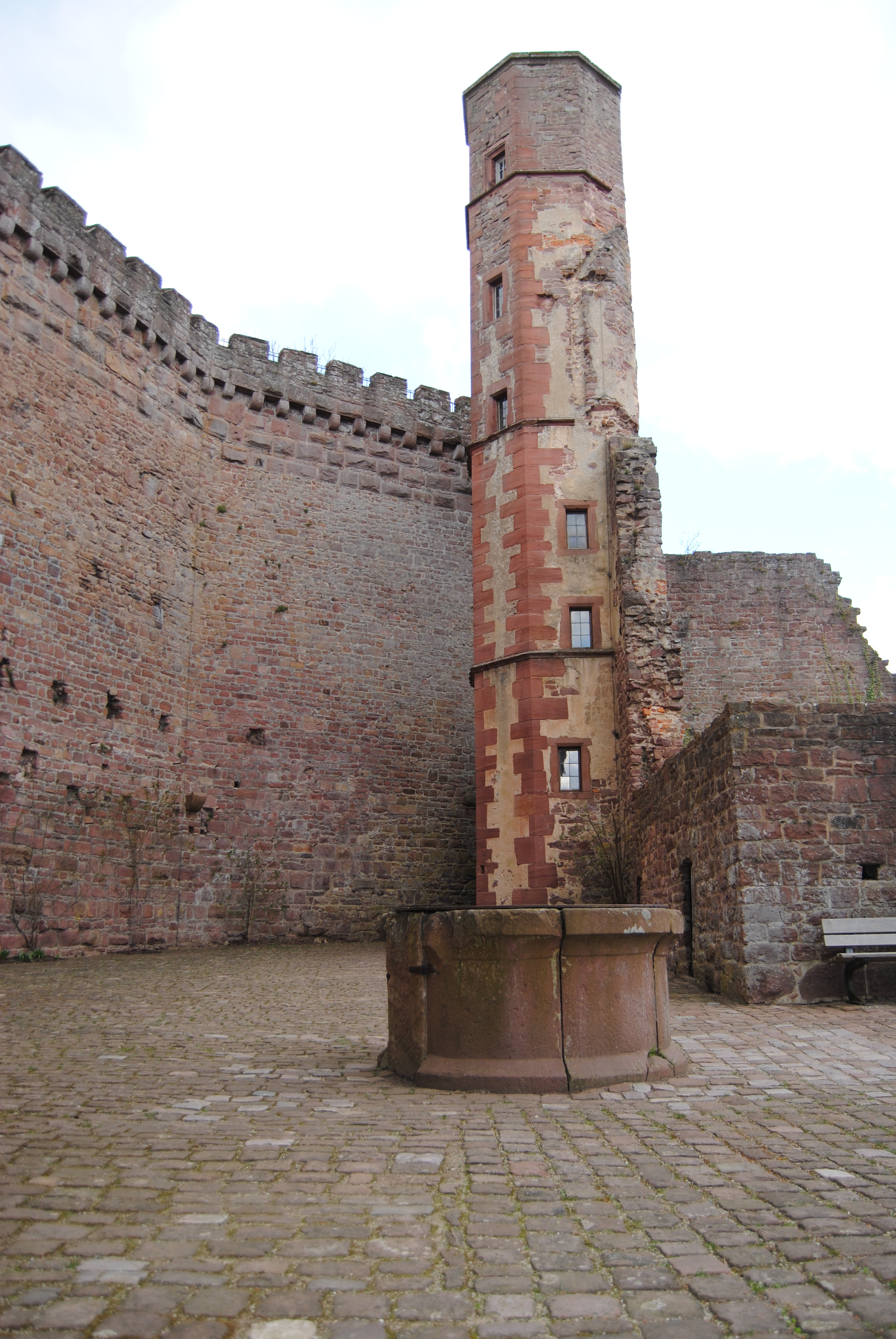



I thought I knew Twain and yet this is all new and wonderfully charming to discover about “A Tramp Abroad.” The secret passage from the well is an astonishing artifact of history and for a fan to press for it to be explored is a wonderful testament to the power of books.
Yes, exactly, Jill! And the discovery of the secret passage adds an element of suspense to the rest of the book. Are those tall tales or not? Answering that question will invite further tramps abroad by his fans.
Frank von Briesen waited 26 years to clear some rubble?
I couldn’t wait that long!
I wonder if there were invaders trying to come in through the well and they dropped rocks on them from above.
I’d be inpatient too, but von Briesen didn’t have the money to do it right away.
The invaders never discovered the tunnel, as far as I know. But you raise an interesting question — why were there rocks in the tunnel? I don’t know.
[…] Mark Twain’s travel literature, it’s not always easy to tell. Germans love to say that Twain’s 1878 raft trip down the Neckar River, a travel adventure covering several chapters in A Tramp Abroad, inspired Huckleberry Finn, […]
[…] and accurate enough he had to have been there. And in Dilsberg, he reported a story about a forgotten tunnel leading from the town well to a place in the woods outside the city walls. An American archaeologist investigating the story discovered the tunnel years later, and it’s […]
I lived in Heidelberg in the 70’s and my 5th grade class took an overnight field trip to Dilsberg. We learned about the well and the secret tunnel. I was even inside the tunnel. I had no idea that Mark Twain was there until I read this post.
You’ve done something I’ve been wanting to do: take a tour of the tunnel! It’s open during the summer months, but unfortunately, it wasn’t open the last time I visited Dilsberg.
I lived almost at the end of IM SCHAFGARTEN in 1973-74. Every morning the shepherd would shepherd his sheep in the street in front of our window toward the apple orchard beyond. Often, a Dampflok would be chew-chewing up the track on the side of the mountain in the distance. One afternoon, shocked, we spied our 2&1/2 year old daughter leading neighborhood kids pied piper-like down the middle of IM SCHAFGARTEN. When we caught up to the parade, she informed us that, “Frau Thomas is waiting for me”. Frau Thomas always gave Elinor a lollipop whenever we shopped at her convenience store. Fond memory of a time long ago.
Nice memories! Sheep are sometimes brought to graze in our town, but we usually don’t see the shepherd. He just puts the sheep into a pasture enclosed by an electric fence.
I studied at Schiller College in 1973-74 and lived outside of the castle. Our landlady’s Oma lived up the road from us within the castle walls and I remember seeing the well. This is fascinating material. I went to Washington and Lee University and will certainly obtain Mrs Ackermann’s Death of an Assassin as well. I brought home from my stay in Germany copies of Twain’s little books, RAFTING ON THE NECKAR and the German version, FLOSSFAHRT AUF DEM NECKAR. On the covers are sketches of the castle with the river flowing around three sides of the hill atop which stands the ancient fortification. My fortunate find. You said you spent an overnight with the kids. Where, might I ask?
Thanks for commenting, Russell. When you say you studied at Schiller College, which one do you mean? Because I live in a former Schiller College town, Bönnigheim. But when you say you remember seeing the well, it sounds like you are talking about Dilsberg and maybe Schiller College in Heidelberg? I also have a copy of a couple of Twain’s books about the Neckar. They are fascinating, aren’t they? At any rate, I hope you enjoy my book, and when you read it, remember that the murder and investigation happened in a Schiller College town, too.
We lived in Dilsberg in the early 1980’s. We lived in the original old Rathaus (town hall) which was several hundred years old. In the basement there was a door to a tunnel leading to the castle. Of course, no one could go in it any more since it was filled with pipes.
What a fascinating piece of Dilsberg history, Lynne. It makes me wonder if there were other tunnels the Dilsbergers used during sieges. Thanks for sharing.
Lol! Hi, Mom. I was just about to write the exact same thing you did. ?
I’m please to host mini-family reunions on my site! Thanks for commenting.
[…] Mark Twain and the Secret of Dilsberg, Germany […]
In 1971, my sister, cousin, and I traveled to Dilsberg and at that time one could pay to enter the tunnel (we did look down the well) then walked along the trail to the location where we found the gated door and entered. The temperature dropped and it became chilly. We were young enough that we could bend over to enter. I remember the large black slugs on the walls. We then found the bottom of the well and looked up to the sky. It was said the tunnel was used for hiding supplies and even people.
Returned to Germany on a business trip in the early 1990s and there was no mention of the tunnel. I asked about it and a woman seemed surprised I even knew about it. She did allow me to take a key to the gate, which was locked. I opened it and looked inside. And there was no way I would enter, nor could I have crouched down as I once did to get inside. All I thought was I must have been really young and limber to bend down enough enter that tunnel. But it was quite an experience in my early 20s. Dilsberg is lovely, interesting, and worth the trip.
What a fascinating story! When I was there, about three years ago, the tunnel was still gated but was opened for tours. I asked about it at the castle and got information about it, so it least it’s on the city’s tourism radar now. And you are right, Dilsberg is an absolutely lovely town. Thanks for commenting!
A couple of clarifications to your narrative:
My grandfather, Fritz (not Frank) von Briesen, and his brother, Hans, visited Dilsberg in about 1894 when they were students at Harvard (Fritz was in the Class of 1895). They both knew about Mark Twain’s story in A Tramp Abroad.
They persuaded some townspeople to lower them down the well, where they found the beginning of a tunnel.
Fritz and Hans returned to the surface where they and the townspeople celebrated with beer! In his exuberance, Fritz promised that if he ever had enough money, he would return to Dilsberg and open the tunnel.
By 1925, Fritz was a patent lawyer in New York City and had enough money. He paid to have it opened in 1926. A plaque recognizing his contribution is above the tunnel entrance (outside the castle wall).
Thanks sooo much for commenting, Hans! That’s amazing that it was your grandfather who visited Dilsberg and rediscovered the tunnel. I’ve been to Dilsberg and can’t recall seeing the plaque, so I’ll have to look for it next time. Have you visited there yourself? Your family history is a part of German history and should be preserved.